

 JAMES HICKMAN improves upon this card kit with some modifications.
JAMES HICKMAN improves upon this card kit with some modifications.
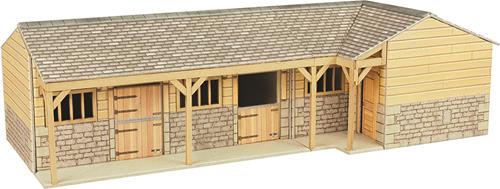 MEPO256 Stables Card Kit, as advertised.
MEPO256 Stables Card Kit, as advertised.
Making a kit can be a rewarding part of the hobby. Watching it evolve and grow as each part is added and expanded really does give a sense of accomplishment and can be much more rewarding than just putting down a ready-built building. With that in mind, the majority of modellers will find there isn't a kit to fit their exact needs or look, and this is where kit modifying or 'kit bashing' comes in. In this article I am not going to radically change the kit, however I will be making some tweaks to improve the finish.
So, where do you begin? Firstly, I started with the basic shell of the kit. I followed the instructions to build the main part of the stable. I made sure to model one of the stable doors in the open position so that the interior can be seen. Now that I have mentioned it, it's time to add an interior.
Interiors can be a hidden gem of many layouts. Although generally not seen on many models, their presence gives the completed look to the buildings they reside in. For these stables, I began by painting the walls. As the model isn't of a specific location, I opted for a generic woody brown colour as seen in many stable blocks.
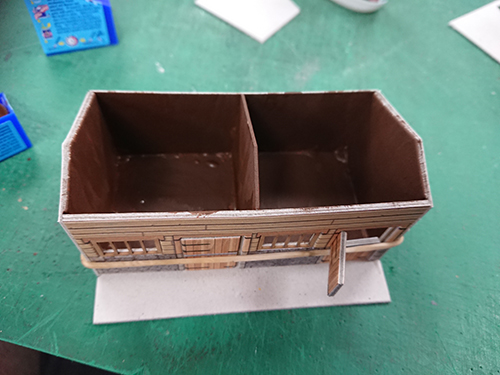
Although not very visible in the completed scene, a roof support was added. When building interiors, it is essential to think about how the building was built. For example, if you are building interiors for houses, don't forget to add a staircase so that the residents can get to the top floor! The supports here were simply cut from matches and glued into place and painted to match the walls. For larger projects, the Plastruct range offers lots of affordable pieces for internal modifications.
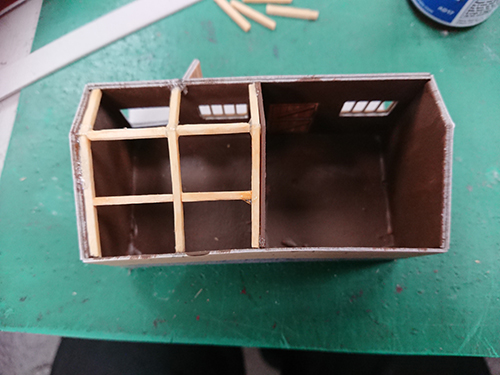
Next I added hay. After all, what else makes a stable comfortable for its residents? Deluxe Materials Speed Bond was added to the base of the stable and Noch N07101 Beige Wild Grass was added on top. Although this is a static grass, I decided just to sprinkle in in by hand to imitate the spread-out hay, not standing as you would find in a field. Finally, for this part of the kit, an addition of a horse was all that was needed to complete the scene.
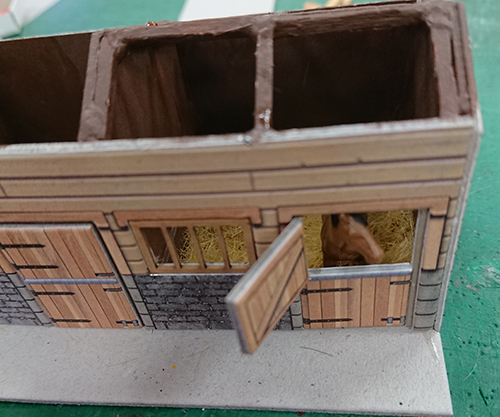
From here I continued the building of the kit. The only additions here were the painting of the empty stable with the same brown paint as before, and the addition of the hay. The kit building following of the instructions stopped again when it was time to join the buildings together. Once they were joined, I noticed a small gap between the two sections.
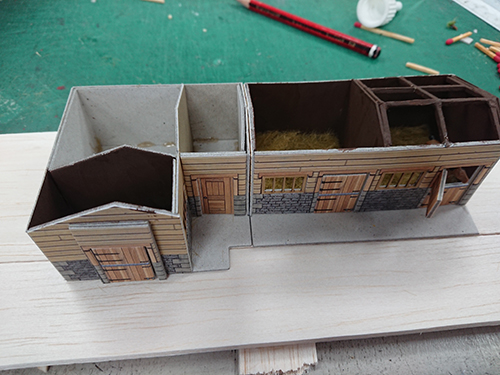
Normally if a gap falls on a corner on down the side of a building, it can usually be disguised by the scenery around it; a plant here, some overgrowth there. As this was right in the centre this approach wouldn't work. Here I turned to the off cuts from the kit.
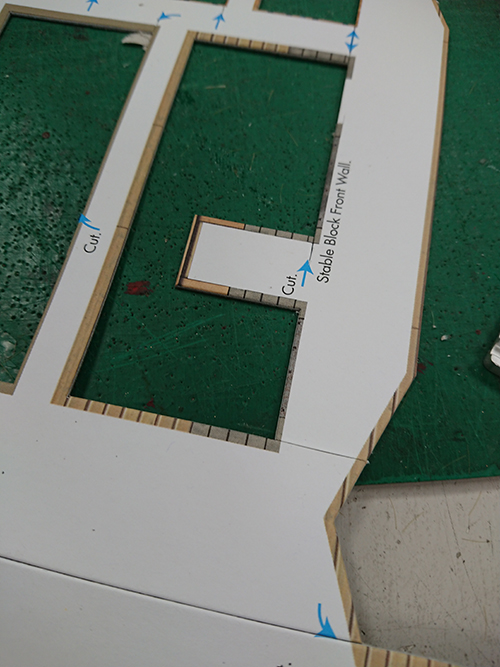
In the above kit you will notice that there is some printing around the edges of the cut-out sections, this is known as a bleed. This is there in case the cutting position and the printing don't quite line up. If the bleed wasn't there, you could end up with some white lines along the edges of the kit where the printing would have been missed. In any case, in these types of kit, this bleed can come in handy.
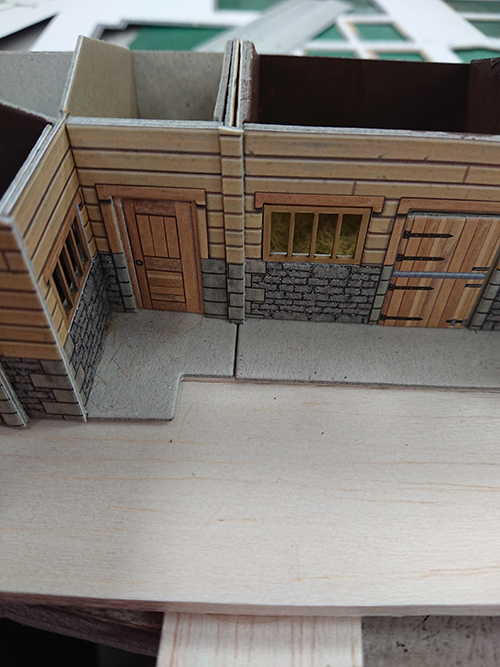
Using a sharp knife or scissors a section of this was cut out, aiming for a piece 2mm wider than the gap to be covered. Once this was removed and squared up, it was glued over the gap to create a more distinctive shape to the building, mimicking the buttress support design on many industrial buildings. The same was done at the rear.
The first major change to the building was the roof. Although there was nothing wrong with the one in the kit, after doing some research on stables in the area it became apparent that the style (a tiled roof) was only for the high-end stable designs. This stable, once completed, was due to go into a farming area on the layout and I didn't want the high-end look that style of roof would give. So instead, I decided a replacement would be required.
The first stage was to create the roof panels. I opted for a corrugated metal look as this style was what appeared a lot in my research. The roof from the kit was used as a template, and the sections cut from a sheet of Slaters Plasticard; SL0436 4mm Corrugations. I must admit here that this wasn't as easy as I had thought. With the shape of the roof being as it is, I did have to recut a couple of sections, as when I dry-tested the parts, it became apparent that the corrugations were running sideways, rather than vertically.
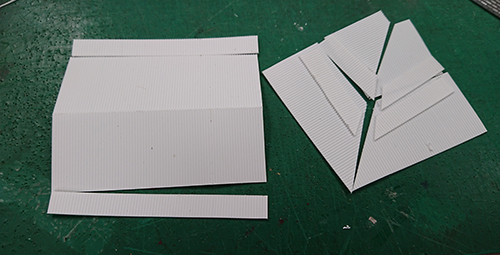
Normally on a standard square house I would simply just replace the roof. On this build however, there were inner and outer corners needing to be replicated. As each section had been replaced, there would have been a need to create a roof support for every section. In this case, for speed and ease, the original roof was attached to the kit, and the corrugated sections glued on top.
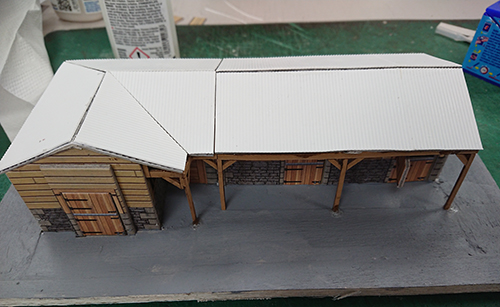
The above image shows the first layer of the roof. A second strip of corrugation was added at the top of the roof, approximately one third of the total depth, for decoration.
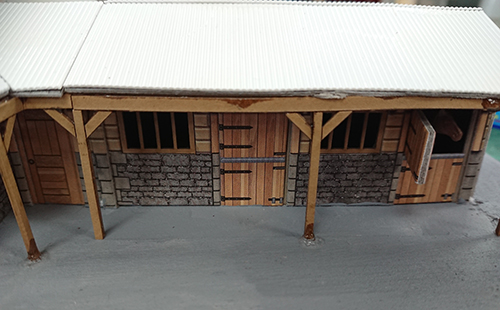
From the image above, you will see that the original card roof is visible underneath the corrugations. This was simply hidden by adding an additional fascia board. This was made from a strip of Plastruct and cut to length. The issue now was that the roof supports that came with the kit were now a different colour to the fascia boards. Because these were part of the kit, it was going to be very difficult to match the colour, so it was decided that both the supports and the fascia boards would be painted in the same colour as the inside of the stables to give the unique colour scheme to the building.
Next attention was turned back to the roof. The corrugations looked nice in place, however because the original roof had been folded, there was a gap between the sections. Instead of trying to rectify this earlier by enlarging the plasticard sections, I had already decided what was going to be done.
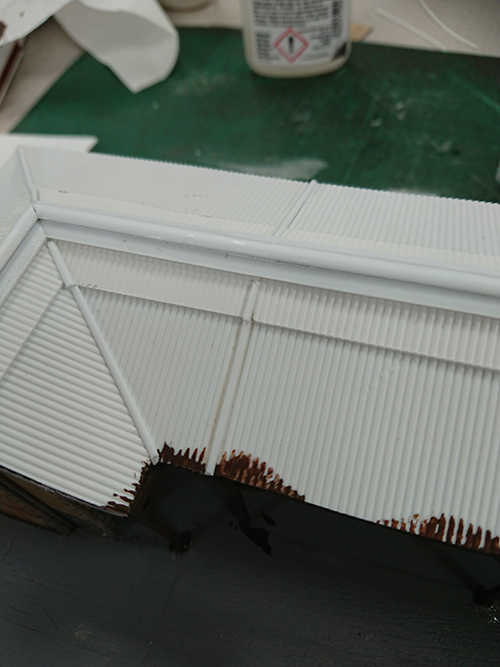
The gaps were crying out for some additional detailing, and this came in the form of more Plastruct. First some strips of plain Plastruct were overlaid right at the top of the corrugated sheets. These were the same ones as were used as the fascia boards previously. Then I used a couple of 'quarter moon' sections and laid them into the gaps. This shape was perfect for this job as it sat perfectly in the gaps and gave the finished look of a capping piece. This technique was also used to cover the joins between panels too, with a smaller 'quarter moon' piece used. To complete the roof, it was painted in a dark grey colour and the kit completed.
The next step was to add the stables to the layout. The area it would be situated was previously the site of a bumpy open field. The stable block was attached onto a balsa wood base to give a clean, smooth area for the yard. The whole base was then attached to the flattened field. The ground was then raised up to the level of the balsa using GM100 Mod Roc and plaster, then given a coat of brown acrylic paint. During this phase, the path up to the stables had also been modelled. The path and the yard were then coated with the Noch Light Brown Texture Paste from the N60823 set.
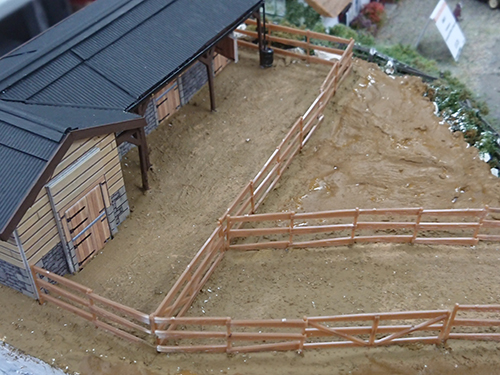
The texture paint gave a nice finish to the surface, but the colour was a bit flat. A lighter brown was used to drybrush the area, bringing the texture more into view. Faller FA180408 Bonanza Fencing was then added round the building and path which was then painted the same brown as the building, to tie the features together.
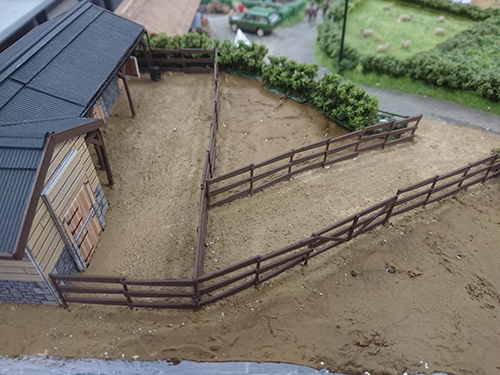
The area around the stable was treated to a healthy helping of Speed Bond before an 'Autumn' static grass was applied. From here it was a simple case of adding the details. Additional ground cover was applied to variate the colours and hedging was installed around the other sides of the field. Noch horses and stable Hands (N15634) were also added, as well as some additional tools and accessories from previous projects. You can see in the picture below where the additional scenics have been applied with the Speed Bond glue. Don't worry, although it looks like everything is covered in snow, the glue does dry clear.
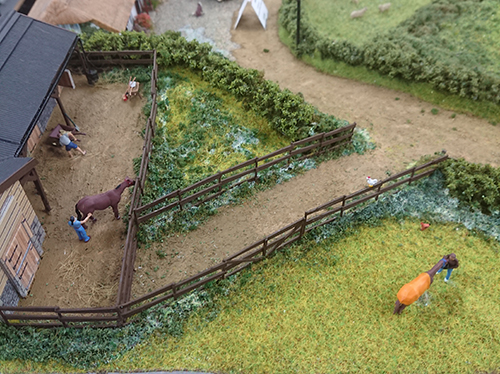
And there we have it. The area is finished.
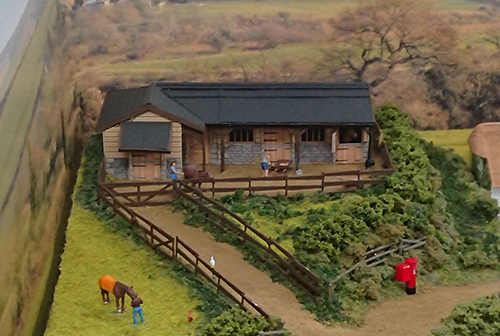
With some small details and a bit of work the stables kit has been modified, improved and made into a unique building, never to be seen on another layout. Modifying kits can be a fun and rewarding exercise, and hopefully in a future edition of RIGHT LINES I will have a look at a bigger modification and details.